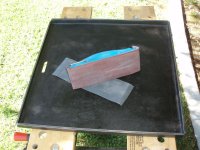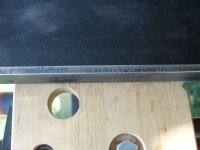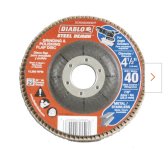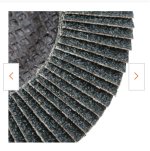We recently bought a 2022 Genesis grill and used it for the first time last night. The Weber Crafted Frame Kit was included with the grill. We ordered the Weber Crafted Flat Top Griddle and also the Pizza Stone. They seem overpriced, but we hope they are "cry once, enjoy for a lifetime" items. It is our hope that when we use the griddle, it will give us something similar to a Blackstone that other family members have.
I wish I could tell you how well it works, but the griddle arrived only yesterday. Furthermore, it requires seasoning before you can use it, so today is seasoning day.
Because it is made from carbon steel rather than cast iron, I expected something thin and relatively lightweight, but the griddle weighs 15-1/2 pounds (7 kg). It was too heavy for the kitchen scale; I had to use the bathroom scale and subtract.
The griddle comes heavily greased in a sealed, thick plastic bag. The griddle itself has a simple flat surface with a raised rim on all four sides. The metal is 3/16 inch (5 mm) thick, measured at the rim. The front rim is lower than the other three rims. You can see that the griddle was made by folding the sides and using weld beads to seal the corners. The corner seal welds were not finished or matched, they are metal blobs. There is no groove or depression to catch grease. There is a small slot near the front. At first I thought it was for a lifting tool, but now I wonder whether it is for channeling grease, where you would allow the grease to fall on the flavorizer bars and into the grill's grease collection system. I wonder if a metal catch cup could be positioned underneath as an alternative. Weber does not mention the slot in the documentation.
The machining along the tops of the rims is not as good as I would have expected. The inside and outside edges are sharp and you can see fine perpendicular saw or grinder marks along the flat top of the rim. I was concerned that I would get cut by a slipping sharp edge as I washed off the protective grease. The griddle was heavy, soapy, and slippery. (The ONLY time you use soap on it!). My concern in real world use is that you could get cut when you put the griddle in or out of the grill's storage locker. Maybe seasoning build-up or heat will eventually roundover the edge. I may take a sanding block and some ultra fine sandpaper and round them over myself. You would think that for $110, Weber would have done a better job finishing the rims.
The fit of the griddle with the frame kit is just okay. I expected a snug fit, but there is some play both left/right and forward/back. By eyeball, the extra space is perhaps 3/8 inch (~9 mm) left/right, and tighter forward/back. Again, more than I would have expected, but it will work fine. The griddle's weight will keep it in place unless you are very aggressive with scraping or push hard against an edge. Weber may argue that the gap is designed as a finger hold when you want to remove it, but they didn't do that with the stainless grill grate.
As I write this, the griddle is in the grill, going through the third seasoning pass. I use flaxseed oil.
Let's be clear that none of these issues will affect the performance or operation of the griddle. We will enjoy using it for many years to come. For the premium price that we paid, I would have expected better from Weber. One reason we chose a Weber grill is that the metal parts have rolled or well-finished softened edges, while their competitors' grills have sharp, unfinished edges on many parts. The edge finishing on this griddle accessory is not up to Weber's standards. We have a very similar griddle that goes with our kitchen cooktop, and it was properly finished with softened edges.
-> I will report back after we have gained some cooking experience with it. That may take a few weeks.
Related:
We did not buy the large Weber Crafted grilling basket, sear grate, or any rotisserie accessories. The baking stone is due to arrive this coming week. We may add the basket, but it seems overly large and overly pricey for our needs. We are shopping for a small basket to try first. After 25 years of losing grilled onions between the grates on our previous grill while being unaware of grill baskets, we are ready to try one.
Photos:
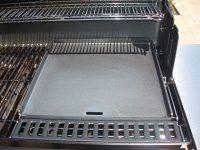
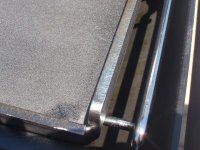
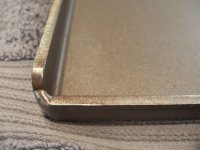
I wish I could tell you how well it works, but the griddle arrived only yesterday. Furthermore, it requires seasoning before you can use it, so today is seasoning day.
Because it is made from carbon steel rather than cast iron, I expected something thin and relatively lightweight, but the griddle weighs 15-1/2 pounds (7 kg). It was too heavy for the kitchen scale; I had to use the bathroom scale and subtract.
The griddle comes heavily greased in a sealed, thick plastic bag. The griddle itself has a simple flat surface with a raised rim on all four sides. The metal is 3/16 inch (5 mm) thick, measured at the rim. The front rim is lower than the other three rims. You can see that the griddle was made by folding the sides and using weld beads to seal the corners. The corner seal welds were not finished or matched, they are metal blobs. There is no groove or depression to catch grease. There is a small slot near the front. At first I thought it was for a lifting tool, but now I wonder whether it is for channeling grease, where you would allow the grease to fall on the flavorizer bars and into the grill's grease collection system. I wonder if a metal catch cup could be positioned underneath as an alternative. Weber does not mention the slot in the documentation.
The machining along the tops of the rims is not as good as I would have expected. The inside and outside edges are sharp and you can see fine perpendicular saw or grinder marks along the flat top of the rim. I was concerned that I would get cut by a slipping sharp edge as I washed off the protective grease. The griddle was heavy, soapy, and slippery. (The ONLY time you use soap on it!). My concern in real world use is that you could get cut when you put the griddle in or out of the grill's storage locker. Maybe seasoning build-up or heat will eventually roundover the edge. I may take a sanding block and some ultra fine sandpaper and round them over myself. You would think that for $110, Weber would have done a better job finishing the rims.
The fit of the griddle with the frame kit is just okay. I expected a snug fit, but there is some play both left/right and forward/back. By eyeball, the extra space is perhaps 3/8 inch (~9 mm) left/right, and tighter forward/back. Again, more than I would have expected, but it will work fine. The griddle's weight will keep it in place unless you are very aggressive with scraping or push hard against an edge. Weber may argue that the gap is designed as a finger hold when you want to remove it, but they didn't do that with the stainless grill grate.
As I write this, the griddle is in the grill, going through the third seasoning pass. I use flaxseed oil.
Let's be clear that none of these issues will affect the performance or operation of the griddle. We will enjoy using it for many years to come. For the premium price that we paid, I would have expected better from Weber. One reason we chose a Weber grill is that the metal parts have rolled or well-finished softened edges, while their competitors' grills have sharp, unfinished edges on many parts. The edge finishing on this griddle accessory is not up to Weber's standards. We have a very similar griddle that goes with our kitchen cooktop, and it was properly finished with softened edges.
-> I will report back after we have gained some cooking experience with it. That may take a few weeks.
Related:
We did not buy the large Weber Crafted grilling basket, sear grate, or any rotisserie accessories. The baking stone is due to arrive this coming week. We may add the basket, but it seems overly large and overly pricey for our needs. We are shopping for a small basket to try first. After 25 years of losing grilled onions between the grates on our previous grill while being unaware of grill baskets, we are ready to try one.
Photos:
- Weber Crafted Flat Top Griddle on the Weber Crafted Frame
- In this photo, the griddle is pushed all the way to the left on the Weber Crafted frame. The gap on the right side shows the amount of left/right "slop" in the fit. In contrast, the regular stainless steel grates are a perfect fit in that same space.
- Flat Top Griddle Machining and Weld - Front Right Corner
- Observe the sharp edges and the machining marks on the rims
- Observe the unfinished weld bead. Compare it with the one on the left side
- Notice the gap on the right side. This is how much left/right slop is in the fit.
- Flat Top Griddle Machining and Weld - Front Left Corner
- The weld bead is larger than the right side.



Last edited:

